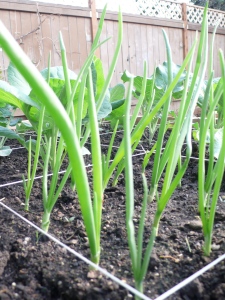This image is part of an article from WIRED magazine’s June Edition. The article has not been posted on the web yet and when it does I will expand on this slightly but it offers some intriguing insight that may allow more geeky garden designs and gives great ideas on how to become more self-sustaining.
It goes so far as to include an apiary, a chicken coop, and a fish pond. The apiary is also known as a bee yard, is where bee’s and honey are kept, and may be a little further than I was planning on going; I’m just not sure if I’m ready to go down the road of beekeeping… However, the chicken coop is on the agenda for this fall and will hopefully be up and running by the spring. The fish pond was something that I initially wrote off as for aesthetics, but upon further exploration of the article it appears that they are actually harvesting the fish!
This is an interesting concept and I had never thought of it up until now but it is something that I believe I will pursue as I move forward. Even though I have been eating tilapia for years I never knew that it was such a hardy easy to grow fish that will produce 1/2 pound of meat for every 1/2 pound of feed! I am already planning on constructing a rainwater garden that will absorb any excess water from the rain barrels by utilizing native plants to use the water all winter and die in the summer if it runs out. However, the idea of adding another level to the ecosystem in my backyard sounds great!
Currently, I have added a few different environments to my yard, including native shade plants like hostas, ferns, and hydrangea’s along the north wall of the house. I have a few sunny areas under a large Pine that host some roses, a little bamboo, some succulents (for the drier areas), and a couple Japanese maples. In order to encourage healthy vegetable growth and lower insect infestations, I have surrounded my 96 sqft of vegetable space with gravel and raised the beds by 18 inches not including the tilled soil underneath. The variation in light and moisture in these boxes is pretty drastic with some getting full sun and arid conditions for peppers, tomatoes and eggplants to some having some shade and moist conditions for leafy greens and lettuces. Along one of the fences I have raspberries and blueberries planted and on the opposite side of the yard, where it won’t shade the vegetables I have a cherry tree in a raised bed as well.
Due to a lack of time I planted the remaining space in the middle of the yard with grass for the year, however, by the time this fall comes around I will have a good portion of covered with a tarp to kill grass and will have added more native grasses and bushes by the spring. Additionally, since I don’t have the time or resources there will be beans and corn planted in the location of the rain garden and chicken coop to utilize the space, but that will not be the case by the spring as I intend to harvest as much rainwater for 2011 irrigation as possible.
I will post more pictures and specifics here as the garden progresses and will also post a link to the full article once it is on the web but until then, get out and garden! Everything you plant will improve the environment, strengthen your bond with your surroundings, and nourish your body and soul!







